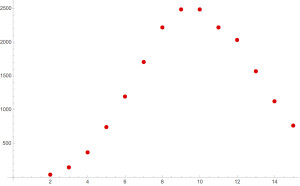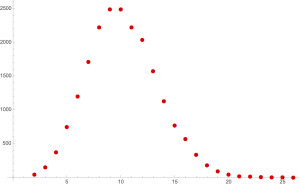The number 3608528850368400786036725
Posted by: Gary Ernest Davis on: February 21, 2015
Ben Vitale (@BenVitale) announced that 3608528850368400786036725 is  a 25 digit number with the property that  each number formed by its first n digits is divisible by n, for n from 1 through 25.
How could we find similar numbers, and could there be a larger number than 3608528850368400786036725 with this property? (which we will call the Vitale property)
The numbers with 2 digits having the Vitale property are just the even numbers between 10 and 98.
We will investigate this issue using Mathematica®, so here’s our list of such 2 digit numbers generated in Mathematica®:
vitaleproperty[2] = Range[10, 99, 2]
{10,12,14,16,18,20,22,24,26,28,30,32,34,36,38,40,42,44,46,48,50,
52,54,56,58,60,62,64,66,68,70,72,74,76,78,80,82,84,86,88,90,92,94,96,98}
How about numbers with 3 digits with the Vitale property?
They have to be obtained from even numbers by adding a digit to the left, and must be divisible by 3.
Here’s how Mathematica® can generate all the numbers obtained by appending a digit from a given number:
adddigits[n_] := Table[FromDigits[Append[IntegerDigits[n], d]], {d, 0, 9}]
For example, here’s what we get by applying the adddigits function to 248:
adddigits[248]
{2480, 2481, 2482, 2483, 2484, 2485, 2486, 2487, 2488, 2489}
To obtain 3 digit numbers with the Vitale property we have to append a digit to even numbers, and check which resulting 3 digit numbers are divisible by 3:
Cases[Flatten[Map[adddigits, vitaleproperty[2]]], x_ /; Mod[x, 3] == 0]
 {102,105,108,120,123,126,129,141,144,147,162,165,168,180,183,186,189,201,
204,207,222,225,228,240,243,246,249,261,264,267,282,285,288,300,303,
306,309,321,324,327,342,345,348,360,363,366,369,381,384,387,402,405,
408,420,423,426,429,441,444,447,462,465,468,480,483,486,489,501,504,
507,522,525,528,540,543,546,549,561,564,567,582,585,588,600,603,606,
609,621,624,627,642,645,648,660,663,666,669,681,684,687,702,705,708,
720,723,726,729,741,744,747,762,765,768,780,783,786,789,801,804,807,
822,825,828,840,843,846,849,861,864,867,882,885,888,900,903,906,909,
921,924,927,942,945,948,960,963,966,969,981,984,987}
 These are the 3 digit numbers divisible by 3, who’s first 2 digits are divisible by 2.
This suggests how we can recursively build n digit numbers with the Vitale property, from n-1 digit numbers with the Vitale property:
vitaleproperty[n_] := vitaleproperty[n] = Cases[Flatten[Map[adddigits, vitaleproperty[n – 1]]], x_ /; Mod[x, n] == 0]
For example:
vitaleproperty[4]
yields:
{1020,1024,1028,1052,1056,1080,1084,1088,1200,1204,1208,1232,1236,1260,1264,
1268,1292,1296,1412,1416,1440,1444,1448,1472,1476,1620,1624,1628,1652,1656,
1680,1684,1688,1800,1804,1808,1832,1836,1860,1864,1868,1892,1896,2012,2016,
2040,2044,2048,2072,2076,2220,2224,2228,2252,2256,2280,2284,2288,2400,
2404,2408,2432,2436,2460,2464,2468,2492,2496,2612,2616,2640,2644,2648,2672,
2676,2820,2824,2828,2852,2856,2880,2884,2888,3000,3004,3008,3032,3036,
3060,3064,3068,3092,3096,3212,3216,3240,3244,3248,3272,3276,3420,3424,3428,
3452,3456,3480,3484,3488,3600,3604,3608,3632,3636,3660,3664,3668,3692,3696,
3812,3816,3840,3844,3848,3872,3876,4020,4024,4028,4052,4056,4080,4084,
4088,4200,4204,4208,4232,4236,4260,4264,4268,4292,4296,4412,4416,4440,
4444,4448,4472,4476,4620,4624,4628,4652,4656,4680,4684,4688,4800,4804,
4808,4832,4836,4860,4864,4868,4892,4896,5012,5016,5040,5044,5048,5072,
5076,5220,5224,5228,5252,5256,5280,5284,5288,5400,5404,5408,5432,5436,
5460,5464,5468,5492,5496,5612,5616,5640,5644,5648,5672,5676,5820,5824,5828,
5852,5856,5880,5884,5888,6000,6004,6008,6032,6036,6060,6064,6068,6092,
6096,6212,6216,6240,6244,6248,6272,6276,6420,6424,6428,6452,6456,6480,6484,
6488,6600,6604,6608,6632,6636,6660,6664,6668,6692,6696,6812,6816,6840,
6844,6848,6872,6876,7020,7024,7028,7052,7056,7080,7084,7088,7200,7204,
7208,7232,7236,7260,7264,7268,7292,7296,7412,7416,7440,7444,7448,7472,7476,
7620,7624,7628,7652,7656,7680,7684,7688,7800,7804,7808,7832,7836,7860,
7864,7868,7892,7896,8012,8016,8040,8044,8048,8072,8076,8220,8224,8228,
8252,8256,8280,8284,8288,8400,8404,8408,8432,8436,8460,8464,8468,8492,
8496,8612,8616,8640,8644,8648,8672,8676,8820,8824,8828,8852,8856,8880,
8884,8888,9000,9004,9008,9032,9036,9060,9064,9068,9092,9096,9212,9216,
9240,9244,9248,9272,9276,9420,9424,9428,9452,9456,9480,9484,9488,9600,
9604,9608,9632,9636,9660,9664,9668,9692,9696,9812,9816,9840,9844,9848,9872,9876}
The size of the collection of n-digit numbers with the Vitale property grows with n for a while, but then begins to decrease:
T = Table[{n, Length[vitaleproperty[n]]}, {n, 2, 15}]
{{2,45},{3,150},{4,375},{5,750},{6,1200},{7,1713},{8,2227},{9,2492},{10,2492},{11,2225},{12,2041},{13,1575},{14,1132},{15,770}}
A plot shows this initials increase and then decrease quite markedly:
ListPlot[T, PlotStyle -> Red, PlotMarkers -> {Automatic, Medium}]
So, lets’s calculate, and plot, the number of n-digit numbers with the Vitale property versus n for n from 2 through 26:
T = Table[{n, Length[vitaleproperty[n]]}, {n, 2, 26}]
{{2,45},{3,150},{4,375},{5,750},{6,1200},{7,1713},{8,2227},{9,2492},{10,2492},{11,2225},{12,2041},{13,1575},{14,1132},{15,770},{16,571},{17,335},{18,180},{19,90},{20,44},{21,18},{22,12},{23,6},{24,3},{25,1},{26,0}}
ListPlot[T, PlotStyle -> Red, PlotMarkers -> {Automatic, Medium}]
So we see that there is exactly one 25 digit number with the Vitale property – the venerable 3608528850368400786036725 – and that appending any of the digits 0 through 9 to this number does not result in a 26 digit number that is divisible by 26. This means that 3608528850368400786036725 is the LARGEST number with the Vitale property.
Kudos to Ben Vitale for finding it!
Postscript: Éric Angelini points out that the number 3608528850368400786036725, and its properties discussed above, appears in the Online Encyclopedia of Integer Sequences.



February 22, 2015 at 5:50 am
See http://oeis.org/A144688
Best,
É.
February 24, 2015 at 7:46 pm
Thanks Éric . Nice reference – guess I should have looked at OEIS first – but nerved thought of looking up a single number!
February 24, 2015 at 7:54 pm
When I bump into a (very) large number like the one you’ve spotted, I always check the OEIS first; so many people have entered so many integers there, that almost every large number having an interesting property is already registred. Anyway, congratulation for your blog — which is always a pleasure to read!